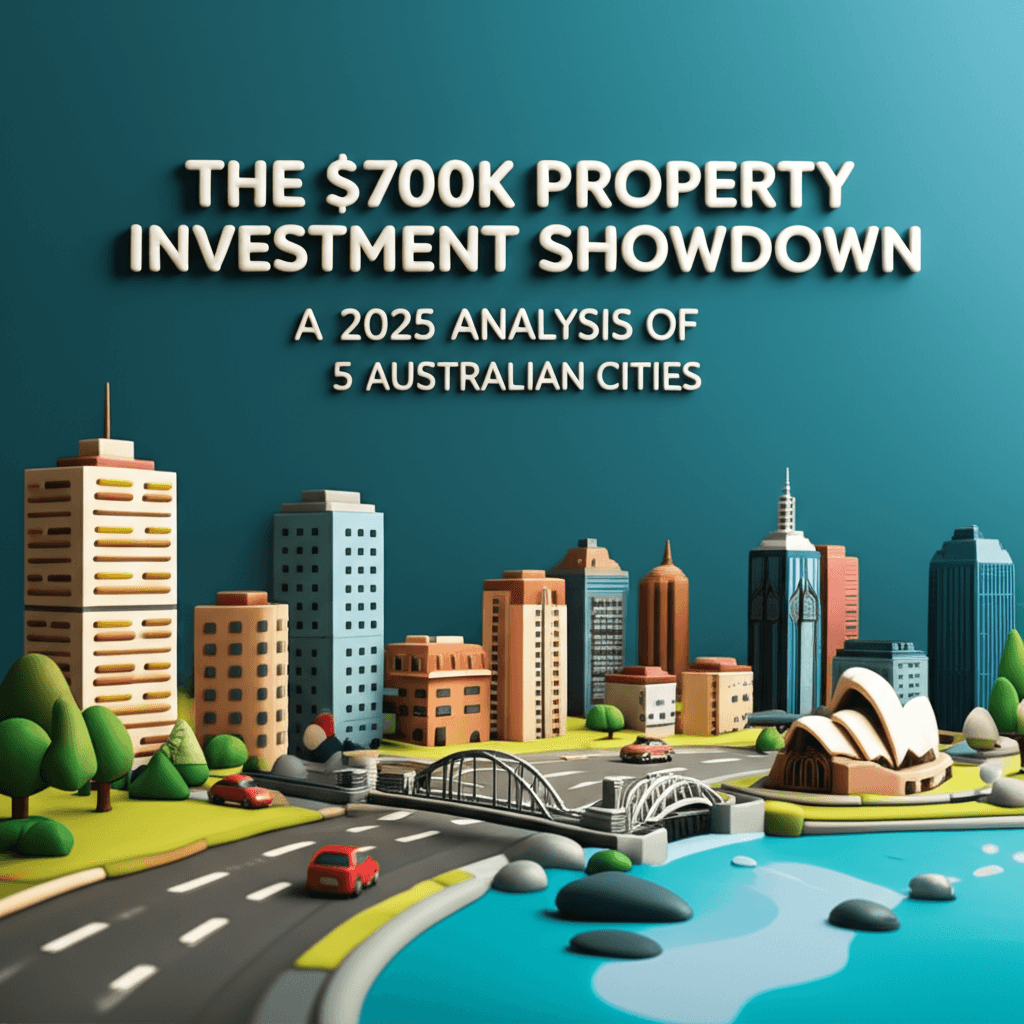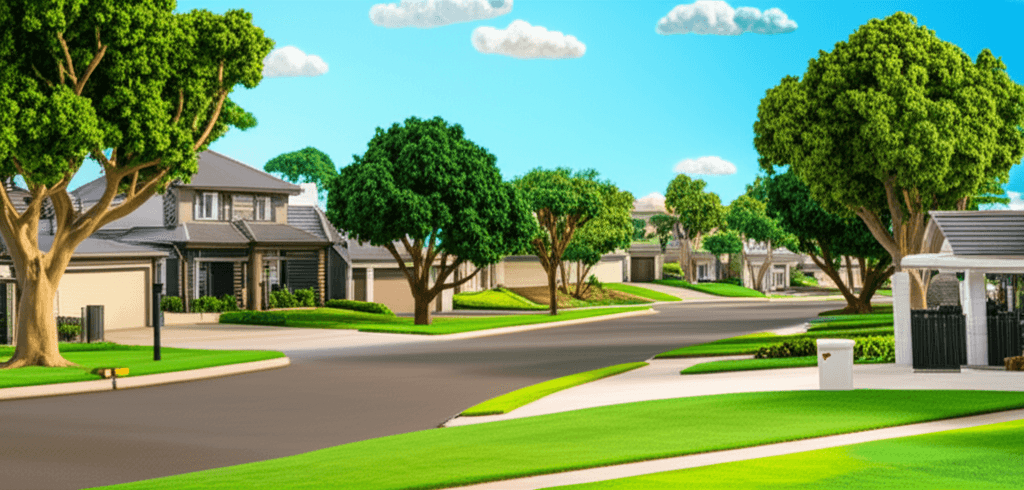The $700k Property Investment Showdown: A 2025 Analysis of 5 Australian Cities
A data-driven comparison of Brisbane, Perth, Adelaide, Melbourne, and Darwin to uncover the best investment opportunities for first-time buyers.

The First-Time Investor's Dilemma
For many first-time property investors in Australia, a budget of around $700,000 is a common starting point. The immediate question is always: where and what should I buy? Friends, family, and even some mortgage brokers often give outdated advice: buy a unit in the suburb you know. They call it a safe 'stepping stone.' However, a deep dive into the data reveals a different story.
Historically, units in major cities like Melbourne and Sydney have shown sluggish capital growth, often as low as 2-3% per annum. This slow growth makes it difficult to build enough equity to refinance and purchase your next property. Instead of a stepping stone, it becomes a financial dead end. A more strategic approach is to look interstate, targeting cities with strong growth drivers and using data to identify high-performing assets. This guide will break down five major Australian cities to see where your $700,000 can work hardest for you in 2025.

Brisbane: Olympic Dreams and Socioeconomic Risks
Brisbane is buzzing with activity, largely driven by massive infrastructure spending in preparation for the 2032 Olympics. This investment is creating new roads, hospitals, public transport, and, most importantly, jobs. The influx of workers fuels population growth and increases demand for housing, which in turn drives capital growth. However, with a $700,000 budget, investors are pushed towards lower socioeconomic suburbs, which carry inherent risks.
In Woodridge, 26km south of the CBD, a typical house is just over $700,000. Key metrics like low vacancy rates (<0.5%) and tight stock on market indicate high demand. The catch? 62% of properties are rentals, and social housing is prevalent. This makes the suburb less resilient during economic downturns. A less risky alternative is Deception Bay, 40km north. For a similar price, you get lower crime, less social housing, and a stronger owner-occupier base (40% renters). While still higher than the ideal 35%, it's a more stable option. The main concern for Brisbane is timing; prices in these areas have more than doubled in the last five years. While the Olympics provide a growth narrative, you're no longer buying at the bottom of the market.
Perth: Riding the End of a Boom
Perth offers relative affordability, allowing investors with $700,000 to buy closer to the city. A three-bedroom house in a family-oriented suburb like Thornley is well within reach. Thornley boasts a very strong owner-occupier presence, with only 21% of residents renting, which fosters market resilience. Investor metrics are solid, with tight vacancy rates and fast selling times (33 days). It's also a positive sign that families are willing to spend up to $900,000 for larger homes in the area.
However, like Brisbane, Perth's market has already experienced a significant boom since bottoming out in 2020. While a further 10% growth in the next 12 months is possible as inventory tightens again, investors entering now are catching the tail end of the cycle. You haven't missed the boat entirely, but you're not early. For those looking to maximise their entry point, there are markets at an earlier stage of their growth cycle.

Adelaide: A Market Showing Signs of Cooling
Adelaide also saw exceptional growth post-lockdown, but recent data suggests the market is losing steam. With a $700,000 budget, you might look at Salisbury, a working-class suburb north of the CBD. The numbers here raise several red flags. Nearly 44% of residents are renters, and properties are taking a slower 48 days to sell. Most concerningly, the months of inventory are trending upwards. When supply outpaces demand, vendors reduce prices, and capital growth stalls.
Suburbs like Richmond have already seen price falls, signaling a broader cooling across the city. Combined with a high crime rate (49/100) and a high renter ratio, Salisbury represents a less resilient market profile. Given that prices have also more than doubled since 2020, buying into a cooling market at a cyclical high is a risky proposition for an investor in 2025.
Melbourne: The Blue-Chip Contender
Melbourne is emerging as a strong contender for investors. Unlike the other cities, it hasn't experienced the same explosive 100%+ growth in recent years, meaning there's more room for a sustained upswing. For around $650,000-$680,000, a suburb like Craigieburn offers a fantastic balance of value and quality. It boasts very low social housing, a low crime rate, and a strong family-dominated demographic.
While selling times are slower (41 days) and vacancy rates are a touch high (1.8%), the long-term fundamentals are compelling. Prices in Craigieburn have only grown by about 30% since 2020, and data shows the market bottomed in late 2023 and is now on a consistent upward trend. The most significant advantage is Melbourne's 'blue-chip' status—it has a 20-year history of steady, reliable capital growth that other cities lack. Buying here is a long-term strategy for stable wealth creation. Understanding these long-term trends is a key part of successful investing, something our Real Estate Analytics tools are designed to help with.
Darwin: High Risk, High Reward
For investors with a higher risk appetite, Darwin presents a compelling, high-octane opportunity. In Palmerston, you can purchase a modern, four-bedroom house in a suburb like Durack for under $700,000 and achieve a rental yield above 6%—significantly higher than any other capital city. The data is explosive: inventory is less than one month's worth and tightening, and Durack has recorded 8% growth in the last quarter alone, annualising to over 30%.
This is the kind of growth that enables you to refinance in 18 months and expand your portfolio. Furthermore, the suburb has zero social housing, a low crime rate, and newer housing stock, meaning lower maintenance costs. The major risk? Darwin is not a 'buy and hold forever' city. It operates in volatile 10-year cycles. If you invest here, you must have a clear exit strategy within the next decade to capitalise on the boom and avoid the subsequent downturn. Finding these niche opportunities requires a sophisticated approach, much like the one offered by our AI Buyer's Agent.

The 2025 Verdict: Choosing Your Strategy
For investors with a $700,000 budget in 2025, the choice boils down to Melbourne and Darwin. Brisbane, Perth, and Adelaide have already had their significant growth runs, and entering now means buying closer to the top of the market.
Choose Melbourne for a long-term, lower-risk, 'blue-chip' investment. You're buying into a resilient market at the beginning of its next growth cycle. It's the asset you can hold until retirement.
Choose Darwin for a short-to-medium-term, high-growth strategy. You accept higher volatility in exchange for potentially rapid equity gains and a superior rental yield, with a plan to sell within the decade.
Your decision depends entirely on your personal risk tolerance and financial goals. Both cities offer a significantly better entry point and value proposition than the other markets discussed.
Conclusion
Successful property investing requires moving beyond familiar territory and using data to make strategic decisions. The common advice to buy a local unit is often a recipe for slow growth. By analysing interstate markets, investors can identify cities at the beginning of their growth cycles. In 2025, with a $700,000 budget, Melbourne and Darwin present the most compelling opportunities—one for steady, long-term wealth creation and the other for rapid, short-term gains. The key is to align your choice of market with your personal investment strategy.
Ready to uncover the next high-growth property market with confidence? Explore our advanced Real Estate Analytics tools to make data-driven decisions for your portfolio.
Frequently Asked Questions
Why is buying a local unit often bad advice for investors?
Buying a local unit is often recommended for its perceived affordability and familiarity. However, units historically show much lower capital growth rates than houses due to the lack of land value appreciation and potential oversupply. This can trap an investor's capital, making it difficult to build enough equity to purchase future properties.
What makes a property market 'blue-chip'?
A 'blue-chip' market, like Melbourne, is characterized by a long history of consistent, steady capital growth and resilience during economic downturns. These markets are typically supported by strong and diverse economies, consistent population growth, and high demand, making them a lower-risk option for long-term investors.
Should I choose Melbourne or Darwin for my $700k investment?
Your choice depends on your investment goals and risk tolerance. Choose Melbourne if you are a conservative investor seeking stable, long-term growth in a proven, resilient market. Choose Darwin if you have a higher risk appetite and are aiming for rapid capital growth and high rental yields, with a clear plan to sell within 5-10 years to realise your gains before the market cycle turns.
